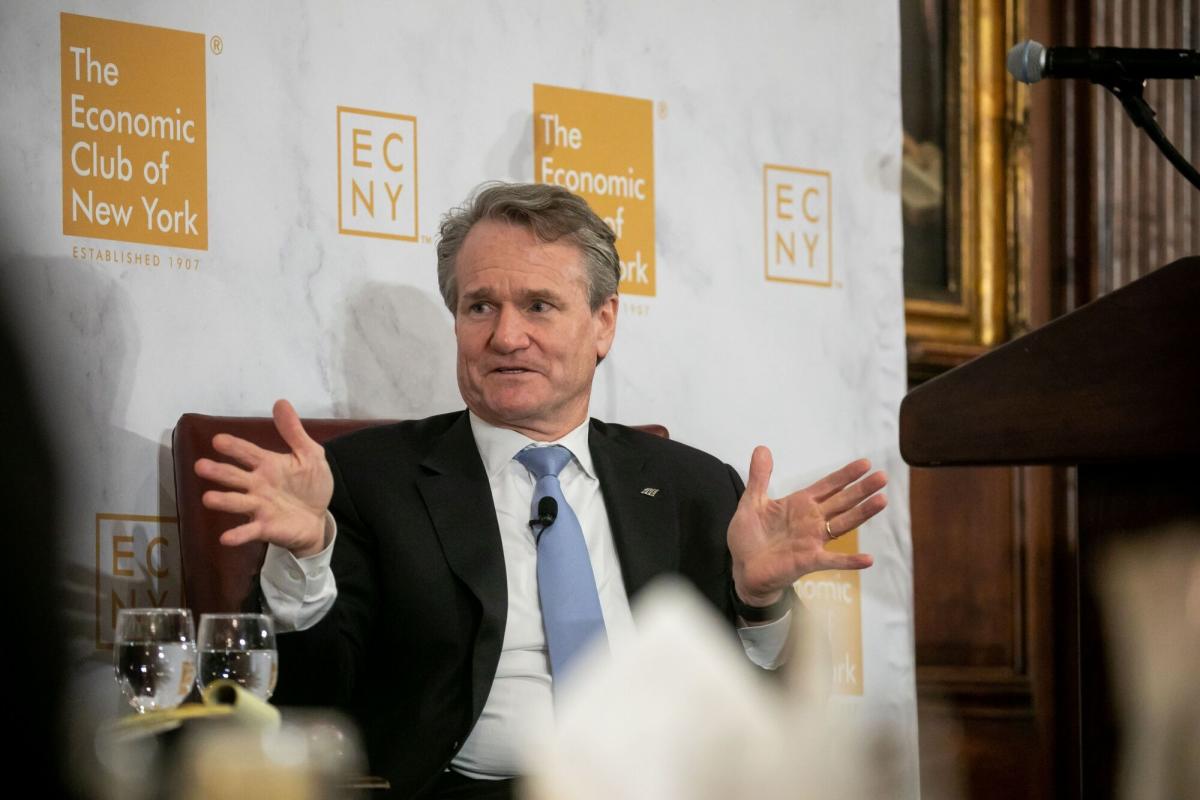(Bloomberg) — For years, Brian Moynihan told investors his bank would be a big winner when interest rates eventually, finally, one day went up. Bank of America Corp. had built a massive deposit base that would allow profits to soar when the Federal Reserve changed course.
Most Read from Bloomberg
Rates have indeed shot up — and BofA is the biggest laggard among the US banking giants. Its investments earn less than its closest rivals, and the stock is the group’s worst performer by far.
In part, that’s because BofA piled hundreds of billions of dollars into long-dated Treasuries and mortgage bonds at low rates that prevailed during the pandemic. The decision is still the subject of finger-pointing within the walls of the second-largest US bank, say people familiar with the matter, now that those holdings are showing huge paper losses and missing out on some of the best rates since 2007.
As BofA’s stock hovered near a three-year low last week, Moynihan, the bank’s chief executive, broached the subject himself at a gathering of his top managers, according to people who heard the remarks, who weren’t authorized to comment publicly. Back during the pandemic, the bank was attracting a flood of extra deposits that it had to put somewhere, and do it prudently, Moynihan told them.
Missed Opportunity
The surge in rates caught some other lenders off guard, too, and the ensuing turmoil led to a wave of regional bank collapses in March. For BofA, the lopsided portfolio isn’t an existential threat, but it is weighing on earnings and investor enthusiasm for the second-largest US bank ahead of its Oct. 17 earnings report.
“The longer-dated securities is money that’s tied up and could otherwise be put to more productive use,” Scott Siefers of Piper Sandler & Co. said in an interview. “It’s a factor in the stock’s performance. And because of their past decisions, BofA has more of a drag than other banks.”
All major lenders suffered setbacks tied to their bond holdings, but BofA stands out for the sheer size and impact. Among the four biggest banks, its securities portfolio is the largest and the lowest-yielding, and it’s concentrated in debt that comes due after 10 years. As for its value, those holdings could erode again if the Fed follows through on another potential rate rise.
The decision to invest in longer maturities dates back to the pandemic when deposits, much of them coming from federal aid, were flooding in faster the loan growth. Paul Donofrio, the CFO at the time, split the cash among longer-term fixed-income products, and the rest went into short-dated and floating rate debt. The move was designed to help protect the bank’s net interest margin if rates didn’t move or declined.
By contrast, JPMorgan Chase & Co.’s CEO Jamie Dimon signaled in October 2020 that his bank was wary of higher rates. “We’re not going to invest in stuff making 50 basis points, 60 basis points, or 70 basis points so we get a teeny little bit more of NII,” he said. “We don’t want to be in a position where we lose a lot of money because we may invest in some five or 10-year securities.”
Ahead of third-quarter results, Wall Street expects BofA’s net interest income to rise 2.7% for the period, the lowest among its peers, compared with JPMorgan’s projection of a 27.5% jump, Wells Fargo & Co.’s 5.5% and Citigroup Inc.’s 3.7%.
Executives have said the situation will improve each quarter as the portfolio shrinks and the remaining bonds become shorter in duration. Even if rates stay where they are, interest income will get a boost because about $10 billion of holdings roll off every quarter, and the proceeds can be reinvested at higher rates.
Chief Financial Officer Alastair Borthwick has said those funds will go into cash, where good yields can be had, or longer-dated investments that now offer better coupons. For now, though, more than a quarter of the bank’s book is stuck in debt securities that collectively yield about 2.4% in a 5% world. On paper, their value is down almost $110 billion as of midyear.
Zero Concern
In practice, Wall Street doesn’t expect the bank to ever realize that loss. With more than $3 trillion in assets and $1.9 trillion in deposits, the bank can afford to wait.
“We just don’t worry about it in the same manner we worry about other banks earlier this year,” Siefers said. “There is zero evidence that BofA will be forced to sell the underlying securities, they will likely just continue to ride out the storm.”
The sharp rise in rates will mean the bond portfolios will again weigh on banks’ ability to raise their capital ratios in third-quarter results, UBS Group AG analyst Erika Najarian wrote Monday in a note to clients. But banks are oversold and when investors stop looking backward at bond losses and rising deposit costs, they’ll start focusing on credit and capital, causing Bank of America to outperform, Najarian said.
Indeed, BofA pays less than 2% on its giant deposit base, so it can still make money on loans and investments, unlike smaller banks that are paying more for new deposits than their older assets are yielding.
“It’s not a capital issue,” Borthwick told analysts at a financial conference last month. “It’s also not a liquidity issue for us. It hasn’t been an earnings issue either.”
Moynihan acknowledged concerns about the low-yielding portfolio last week to senior management during their end of the year strategy meeting at BofA’s headquarters in Charlotte, North Carolina, according to people familiar with the session. He told them the huge influx of deposits left BofA pretty much no option at the time, and they chose to put the money to work in a responsible way.
Containing Risk
That’s in line with Moynihan’s long-running mantra of “responsible growth” during his 13-year tenure as CEO — a strategy designed to make money without taking undue risks.
Some insiders have complained that the strategy is too conservative and misses growth opportunities. Moynihan told them at the meeting that while everyone is focused on the “responsible” part, they need to remember that the word “growth” is also included in that phrase.
While unrealized losses may concern investors, they aren’t an issue for the typical bank customer, according to RBC Capital Markets analyst Gerard Cassidy. That combined with the sheer level of insured consumer deposits means BofA is far less likely to succumb to the sort of deposit flight that sank Silicon Valley Bank.
“You think somebody with $50,000 at Bank of America cares about the unrealized bond losses? Of course not,” Cassidy said. “The underlying bond losses are something the equity investors are focused on.”
–With assistance from Sridhar Natarajan, David Scheer and Max Reyes.
(Updates with UBS comments in the 15th paragraph)
Most Read from Bloomberg Businessweek
©2023 Bloomberg L.P.

Barbara Terrio is a seasoned business journalist, delving into the world of finance, startups, and entrepreneurship. With a knack for demystifying complex economic trends, she helps readers navigate the business landscape. Outside of her reporting, Barbara is an advocate for financial literacy and enjoys mentoring aspiring entrepreneurs.






:max_bytes(150000):strip_icc()/The-Best-7-Day-Walking-Plan-for-Insulin-Resistance-8cf4c8a8c16e4dddac34d5d97633e91f.jpg)

